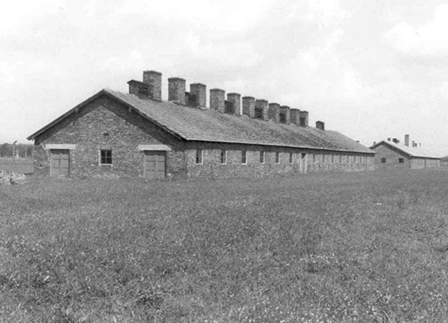- Caption
- Under the supervision of American soldiers, German civilians view the bodies of female prisoners exhumed from a mass grave near the Helmbrechts concentration camp, a sub-camp of Flossenbuerg.
- Date
-
1945 April 18
- Locale
- Helmbrechts, Germany
- Photo Credit
- United States Holocaust Memorial Museum, courtesy of Nathan Weil
- Event History
- Towards the end of the war, as Allied troops closed in on Germany from all sides the prisoners in concentration and slave labor camps were evacuated to camps further from enemy lines. Although some prisoners were evacuated by train, most were sent on forced marches that covered hundreds of miles. One such "death march" began in Gruenberg, a sub-camp of Gross Rosen in Lower Silesia. The 900 female prisoners of Gruenberg were evacuated along with a similar number of female prisoners from the Gross Rosen sub-camp of Schlesiersee. The prisoners were divided into two smaller groups and accompanied by SS men and women. Approximately 1,100 prisoners were sent in the direction of the Flossenbuerg concentration camp, while the remainder was sent to Bergen-Belsen. On January 29, 1945 the two groups left Gruenberg, unaware of the long journey ahead. Although each of the prisoners had been given a blanket before their departure, few had proper shoes, and some walked barefoot or only with cloth wrapped around their feet. They were forced to march from 9-18 miles a day, receiving only a few potatoes or a small bowl of soup once a day for nourishment, occasionally going without food for one or two days. At night the women slept in unheated barns or out in the open. Several prisoners died each day from frostbite, starvation, and fatigue. Many others were killed by SS guards for attempting to escape or lagging behind. Amalie Mary Reichmann (later Robinson), a survivor of the march, recalled that on one occasion when several women had tried to escape, the SS lined up all the prisoners and shot every tenth one. After several weeks of marching, the group reached Dresden just as it was fire-bombed by Allied planes on February 13-14. Finally, on March 6, after five weeks of marching, the first group of prisoners reached Helmbrechts, a sub-camp of Flossenbuerg, 300 km. from Gruenberg. Of the original 1,100 prisoners who set out on the death march, 150-250 had died along the way, and another 330 had been left at other camps. 621 arrived in Helmbrechts. Upon arrival, the women were issued clothing to replace their lice infested garments and were put into separate barracks. Because they were too weak to work, they were given only a minimal amount of food. During their five-week stay at Helmbrechts, an additional 40 women died. On April 13, the remaining women were sent on a second death march along with the rest of the 590 prisoners from Helmbrechts. The group which headed toward the southeast, ended up in Volary, Czechoslovakia, 200 km. away. After the liberation of Helmbrechts and the surrounding area by American troops, a mass grave was discovered near the concentration camp. On April 18, American soldiers forced German civilians to exhume the grave, which contained the bodies of 22-30 female prisoners. Although the women were not identified, it is possible that they had participated in the death march from Gruenberg, and were some of the 40 who died in Helmbrechts during their five-week stay.
[Sources: Goldhagen, Daniel. Hitler's Willing Executioners: Ordinary Germans and the Holocaust.
(New York: Alfred A. Knopf, 1996); Klein, Gerda Weismann. All But My Life. (New York: Noonday Press, 1998); Robinson, Amalie Mary. The Reichmanns of Bielitz. (Los Angeles: s.n., 1992). USHMM Archival Vertical File, "Volary."]
See https://www.ushmm.org/wlc/en/article.php?ModuleId=10005454.
See Also https://www.ushmm.org/wlc/en/article.php?ModuleId=10005537.
See Also https://www.ushmm.org/wlc/en/article.php?ModuleId=10005162.
See Also "Grünberg I," "Grünberg II," "Helmbrechts," "Schlesiersee I," and "Schlesiersee II" in Encyclopedia of Camps and Ghettos, Volume 1 Part A.



